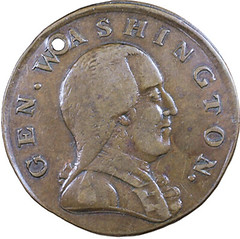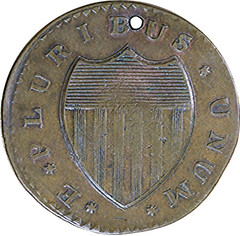
PREV ARTICLE
NEXT ARTICLE
FULL ISSUE
PREV FULL ISSUE
NEWS FROM 7/28/1884: NJ WASHINGTON COPPERI've always enjoyed old newspaper articles relating to numismatics - there is a large world of interesting and often overlooked information waiting to be discovered (or rediscovered) by today's collectors and researchers. For some time now I've wanted to have a regular E-Sylum article featuring these delightful snippets - even ones that are laughably incorrect. Researcher and longtime E-Sylum contributor Julia Casey offered to kick off such a series. Here is her first contribution, on the rare "New Jersey Washington" Copper. Readers are welcome to send in their own contributions - we'd love to hear from you. -Editor In the January 1874 edition of the American Journal of Numismatics, William Sumner Appleton published an article titled "Newspaper Cuttings." He explained he was inspired to do so as "A VERY curious if not valuable paper might be made up from the many little items concerning numismatics which have appeared in the newspapers of late years. I propose to try something of the kind, to preserve in the Journal various facts, which have never yet been printed there." In furtherance of this noble enterprise, below is a numismatics-related newspaper article that appeared in the July 28, 1884 edition of The Times (Philadelphia). Haseltine on the "New Jersey Washington" Copper John W. Haseltine, the antiquary and numismatist, tells a curious story of his accidental discovery of the General Washington penny of New Jersey. "One day an old man, a total stranger to me," said Mr. Haseltine, "came into my place with a number of old copper coins he wished to sell. After a little discussion in regard to the price I bought the lot, which seemed to consist altogether of trash, at the rate of about two cents apiece. They were dirty and in very poor condition. After they had been washed and the acids applied I discovered this one, the only one of its kind, to my knowledge, in existence. Dr. Maris came in to see me a few days after this and I offered him the coin for forty dollars. He refused to give more than thirty, and when he came back the next day to give me my own price for it I told him I had been thinking all night about that penny and it shouldn’t go for less than a hundred. This made him angry and he went away. I sold it in New York two weeks afterwards for $150. This was eight years ago. After the man who bought it died his collection was sold at auction and the coin passed into the hands of L.G. Parmalee, of Boston, who paid $610 for it. This gentleman possesses the finest cabinet of coins in the United State. It contains more unique specimens than half a dozen other cabinets put together and must have cost him not less than $50,000. A hundred thousand dollars couldn’t buy it."
The "General Washington penny of New Jersey" is pictured in Neil Musante’s Medallic Washington on page 11 and indexed as GW-04. Per Musante, quoting Baker: "This piece, found in a lot of old coppers about ten years ago, by Mr. John W. Haseltine, of Philadelphia, was purchased at the Crosby sale, June, 1883, by Lorin G. Parmelee, of Boston, for six hundred and twenty dollars, the highest price as yet paid for any single Washington piece. The date is probably 1786." This coin is more commonly known as the "New Jersey Washington Cent" and has been attributed to Walter Mould, who was also involved in the minting of New Jersey coppers. Musante indicates there are presently "3 known." Haseltine’s example is shown in the 1908 article: The coin imaged by Musante is from the collection of Syd Martin and is a different coin than Haseltine’s (notably it has sharper detail and has been holed):   Haseltine told his story again at the 1908 A.N.A. Convention (published in the October-November 1908 edition of The Numismatist). It is this reiteration, rather than the 1884 newspaper article, which appears to be the source for the standard history of the coin. However, some details are different from what was reported in 1884: The unique New Jersey Washington cent was brought into my store in a bag with about one thousand other copper pieces covered with grease and dirt. They were accumulated in a small grocery store kept by an old woman who was so suspicious that she would not get what they were worth that every coin I looked at carefully she quietly slipped in her pocket after I laid it down. Realizing at that rate I would get nothing examined, I merely counted them - (noticing the New Jersey cent but not daring to examine it to see if it was copper or lead) and as most of the pieces were common United States Colonials and foreign coins I obtained them at two cents each. After she left the store I hastily looked over them until I found the New Jersey Washington and ascertained it was a struck piece in copper. I offered it to Dr Maris of this city for fifty dollars, he declined to purchase, saying the price was too high. Realizing after research that I had a unique coin I then sold it to Mr. S.S. Crosby of Boston for one hundred and fifty dollars. You probably know of its history since, and that no other has ever been discovered. It would probably sell now for about fifteen hundred dollars. It should be noted that in the 1884 article Haseltine does not mention Crosby by name but states that "After the man who bought it died his collection was sold at auction and the coin passed into the hands of L.G. Parmalee, of Boston, who paid $610 for it." Sylvester Crosby’s collection was cataloged by Haseltine and auctioned in 1883. The New Jersey Washington Cent sold as lot 1165. However, Crosby did not die until 1914. A January 27, 1951 letter from John Ford to Eric Newman archived on the Newman Numismatic Portal traces what Ford believed to be the 3 known examples. Haseltine’s coin is said at that time to be
in the Garrett collection at Princeton University, the Martin coin is traced to the 1914 Parsons sale, and the third specimen is from the James Ten Eyck Collection in 1922 and was owned by F.C.C.
Boyd in 1951. Ford admits some confusion over the provenance of the Haseltine coin and the Ten Eyck coin. His letter can be found here:
Do any E-Sylum readers have information on the whereabouts of the Haseltine and Ten Eyck coins?  Wayne Homren, Editor The Numismatic Bibliomania Society is a non-profit organization promoting numismatic literature. See our web site at coinbooks.org. To submit items for publication in The E-Sylum, write to the Editor at this address: whomren@gmail.com To subscribe go to: https://my.binhost.com/lists/listinfo/esylum All Rights Reserved. NBS Home Page Contact the NBS webmaster 
|
